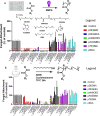A potential alternative to fungicides using actives-free (meth)acrylate polymers for protection of wheat crops from fungal attachment and infection
- PMID: 38013846
- PMCID: PMC10614722
- DOI: 10.1039/d3gc01911j
A potential alternative to fungicides using actives-free (meth)acrylate polymers for protection of wheat crops from fungal attachment and infection
Abstract
Fungicidal compounds are actives widely used for crop protection from fungal infection, but they can also kill beneficial organisms, enter the food chain and promote resistant pathogen strains from overuse. Here we report the first field crop trial of homopolymer materials that prevent fungal attachment, showing successful crop protection via an actives-free approach. In the trial, formulations containing two candidate polymers were applied to young wheat plants that were subject to natural infection with the wheat pathogen Zymoseptoria tritici. A formulation containing one of the candidate polymers, poly(di(ethylene glycol) ethyl ether acrylate) (abbreviated DEGEEA), produced a significant reduction (26%) in infection of the crop by Z. tritici, delivering protection against fungal infection that compared favourably with three different commercially established fungicide programmes tested in parallel. Furthermore, the sprayed polymers did not negatively affect wheat growth. The two lead polymer candidates were initially identified by bio-performance testing using in vitro microplate- and leaf-based assays and were taken forward successfully into a programme to optimize and scale-up their synthesis and compound them into a spray formulation. Therefore, the positive field trial outcome has also established the validity of the smaller-scale, laboratory-based bioassay data and scale-up methodologies used. Because fungal attachment to plant surfaces is a first step in many crop infections, this non-eluting polymer: (i) now offers significant potential to deliver protection against fungal attack, while (ii) addressing the fourth and aligning with the eleventh principles of green chemistry by using chemical products designed to preserve efficacy of function while reducing toxicity. A future focus should be to develop the material properties for this and other applications including other fungal pathogens.
This journal is © The Royal Society of Chemistry.
Conflict of interest statement
There are no conflicts of interest.
Figures



References
-
- Hyde K. D. et al., The Amazing Potential of Fungi: 50 ways we can exploit fungi industrially. Fungal Diversity. 2019;97:1–136. doi: 10.1007/s13225-019-00430-9. - DOI
LinkOut - more resources
Full Text Sources
